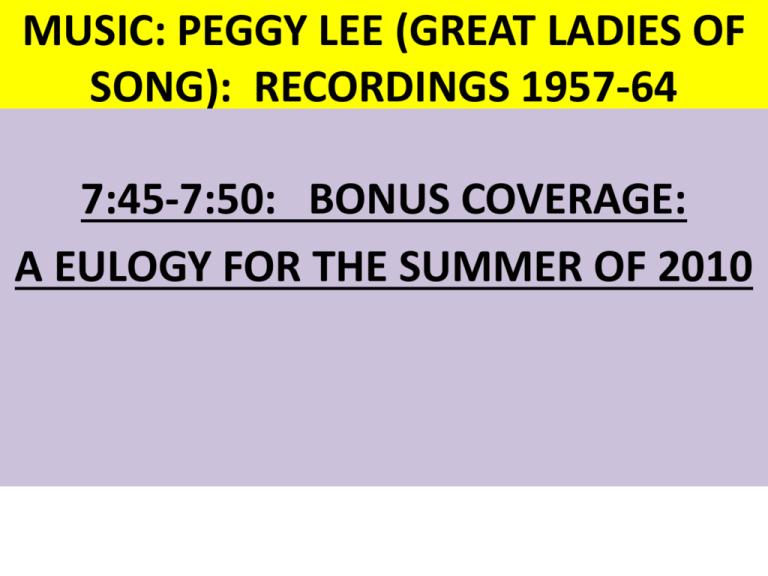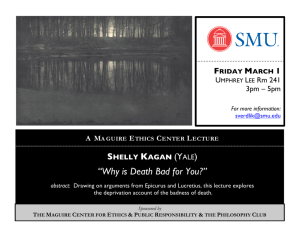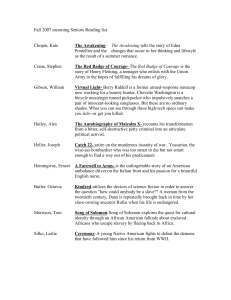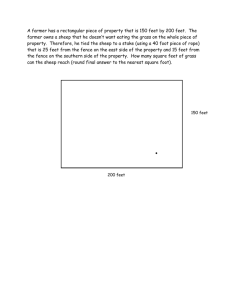Power Point (9/22-23)
advertisement

MUSIC: PEGGY LEE (GREAT LADIES OF SONG): RECORDINGS 1957-64 7:45-7:50: BONUS COVERAGE: A EULOGY FOR THE SUMMER OF 2010 FINAL EXAM: THREE OUT OF FOUR Qs • Question One: Lawyering – What Legal & Factual Research Would You Do to Advise Client? – Tasks: • Identifying Legal Issues • Identifying Possible Legal Rules (& Checking For) – Caselaw, Statutes, Constitutional Provisions, etc. • Identifying Possibly Relevant Facts & Ways of Finding (e.g., Assignment 2: Witness Interview) FINAL EXAM: THREE OUT OF FOUR Qs • Question One: Lawyering • Question Two: Short Problems (3 out of 4) – Like Most of the Review Problems – Tasks: • Applying Rules to Facts • Finding Strongest Arguments for Each Party • Using Policy Arguments to Resolve Disputed Qs FINAL EXAM: THREE OUT OF FOUR Qs • Question One: Lawyering • Question Two: Short Problems (3 out of 4) • Question Three: Judicial Opinion/Dissent – Write Draft of Majority & Dissenting Opinions Resolving One or Two Narrow Legal Questions – Tasks: • Finding Strongest Arguments for Each Party • Using Policy Arguments to Determine Appropriate Rule FINAL EXAM: THREE OUT OF FOUR Qs • Question One: Lawyering • Question Two: Short Problems (3 out of 4) • Question Three: Judicial Opinion/Dissent • Question Four: Traditional Issue-Spotter – Long Fact-Pattern: Discuss Legal Issues Raised – Tasks: • • • • Identifying Legal Issues Applying Legal Rules to Facts Finding Strongest Arguments for Each Party Using Policy Arguments to Resolve Disputed Questions FINAL EXAM: THREE OUT OF FOUR Qs NO Qs NOW: SAMPLES OF EACH TYPE OF Q & MUCH MORE DETAIL ON EXPECTATIONS LATER IN THE COURSE!!!! Maguire: Why Look at in Detail? • Examples of Possible Rules (Caselaw & Statutory) to Cover Ranchers v. Farmers and Similar Disputes • Example of More Limited Role of State Supreme Court when Legislature has Spoken • Can Argue: Example of a Situation Where Optimal Results Require Legislation/Regulation and Thus (Maybe) Courts Shouldn’t Try to Make New Law • Good Fact Pattern for Exploring Relevant Policies McCarty: Why Look at in Detail? • Example of Early Strict Liability Version of Nuisance, Where Only Defenses Are: 1. Coming to the Nuisance 2. Oversensitiveness • Good Fact Pattern for Exploring Relevant Policies McCARTY: RELEVANCE ANALYSIS Harm at Issue • Nature of Harm: – Discomfort & Annoyance – Cleaning Rugs – Loss in Rental Value • • • Think About Meaning of “Property Value” Aggregate Opinion of Potential Renters or Buyers Incorporates Both Rational & Irrational Concerns McCARTY: RELEVANCE ANALYSIS Harm at Issue • Nature of Harm: Discomfort & Annoyance; Cleaning Rugs; Loss in Rental Value • Dissent: no tangible permanent harm (implicitly: therefore oversensitive) McCARTY: RELEVANCE ANALYSIS Harm at Issue • • Nature of Harm: Discomfort & Annoyance; Cleaning Rugs; Loss in Rental Value Dissent: no tangible permanent harm • Majority (last sentence): material interference w “physical comfort” plus “financial injury” is sufficient (implicitly: not oversensitive) McCARTY: RELEVANCE ANALYSIS • Relevant: – Coming to the Nuisance – Extent of Harm v. Oversensitiveness (Considering Location) • Not Relevant – Costs to D of Avoiding Harm – Utility of D to Society • Note: Not Mentioned at All – Harm from D to Non-Parties – Harm from D to Environment McCARTY: RELEVANCE ANALYSIS Qs on McCarty? NOTES AFTER MAGUIRE: MORE RELEVANT CONCERNS • Notes 2-10 after Maguire are not specifically about the case or specific rules but about how to decide what the rules should be. • We’ll look at to help decide what kinds of concerns ought to be relevant in conflicting land use cases. • Can use as basis for policy arguments, especially in opinion/dissent Q • Go through pretty quickly (slides posted Thurs). NOTES AFTER MAGUIRE: FAIRNESS Fairness = Perception that Result is “Just” • Important: “Fairness” and “Justice” are Not SelfDefining Concepts • Always Need to Defend Claim: – “This result would be fair because …” – “Rewarding the defendant’s behavior here would be unjust because …” NOTES AFTER MAGUIRE: FAIRNESS Fairness: Possible Examples • Fair: Making people pay for harms they “caused” & not for harms they didn’t – Maybe unfair to force farmer to spend $$ on fence even to protect much larger value of own crops if damage seen as “caused” by rancher’s cattle. – Maybe shouldn’t reward “Coming to the Nuisance” because Plaintiff “caused” own harm. NOTES AFTER MAGUIRE: FAIRNESS Fairness: Possible Examples • Fair: Making people pay for harms they “caused” & not for harms they didn’t • BUT: Can be difficult to decide who “caused” problem (Reese’s; Note on P128-29) NOTES AFTER MAGUIRE: FAIRNESS Fairness: Possible Examples • Unfair to make punishment disproportionate to harm caused – Don’t enjoin defendant for “trivial” harm to P – Maybe: Don’t lose title to border strip for not knowing precise property line. Qs on Fairness Arguments NOTES AFTER MAGUIRE: ECONOMIC EFFICIENCY Economic Efficiency = Maximizing Economic Value. In Context of Maguire Means: • Allocation of resources to farming, ranching, fencing and other preventative measures that yields best overall economic value to society. • In other words, best combination of – Increasing value of resources like cattle & crops – Minimizing costs like fencing & lost crops NOTES AFTER MAGUIRE: ECONOMIC EFFICIENCY Economic Efficiency = Maximizing Economic Value. In Context of Maguire Means: • Allocation of resources to farming, ranching, fencing and other preventative measures that yields best overall value to society. • Examples: – Efficient to put up $10K fence to prevent $2 million damage to crops – Not efficient to put up $2M fence to prevent $10K damage to crops NOTES AFTER MAGUIRE: ECONOMIC EFFICIENCY Economic Efficiency = Maximizing Economic Value. In Context of Maguire Means: • Allocation of resources to farming, ranching, fencing and other preventative measures that yields best overall value to society. • Maguire & McCarty do not address (Carpenter does) – Maguire leaves analysis to legislature – McCarty doesn’t consider relative costs of allowing D to continue as is v. alternate production method NOTES AFTER MAGUIRE: ECONOMIC EFFICIENCY Efficiency Sometimes Conflicts with Fairness • E.g., Adverse Possession – Fairness: Desire for Justice May Favor Good Intent over Bad Intent – Efficiency: Expensive to Determine Intent, Especially for Long Time Period. • Qs? NOTES AFTER MAGUIRE: Externalities (Note 3: P63-64) • EXTERNALITY = Cost or benefit external to a decision-making process – Must be with reference to particular decision – Helpful to start by identifying decision-maker: e.g., rancher (R) deciding whether to build fence or take other steps to keep herd in. NOTES AFTER MAGUIRE: Externalities (Note 3: P63-64) • Cost or benefit external to a decision-making process (R deciding whether to build fence or take other steps to keep herd in) • In pure “fence out” jurisdiction, R not liable for damage to farmer’s crops, so no reason to consider = externality NOTES AFTER MAGUIRE: Externalities (Note 3: P63-64) • Cost or benefit external to a decision-making process (R deciding whether to build fence or take other steps to keep herd in) • If decision-maker considers a cost, but chooses to absorb it, not an externality – E.g., R presumably will consider cost of cattle getting killed b/c outside his control, so even if R chooses no fence, this cost not an externality NOTES AFTER MAGUIRE: Externalities (Note 3: P63-64) “Internalizing” Externalities: • Forcing Decision-Maker to Consider Costs or Benefits that Had Been Outside DecisionMaking Process • Beneficial/Efficient Because Means Price of Activities Will Reflect Real Cost (e.g., pollution costs) NOTES AFTER MAGUIRE: Externalities (Note 3: P63-64) “Internalizing” Externalities: • Forcing Decision-Maker to Consider Costs or Benefits that Had Been Outside Decision-Making Process • Can Internalize Several Ways – Require Payment of Damages – Criminalize or Enjoin the Activity – Private Negotiation (Bribes) NOTES AFTER MAGUIRE: Externalities (Note 3: P63-64) “Internalizing” Externalities: Example • Initially, when deciding whether to create Herd Districts, residents did not have to consider costs (damages or fences) that then fell on Rs using adjoining land for grazing. NOTES AFTER MAGUIRE: Externalities (Note 3: P63-64) “Internalizing” Externalities: Example • Initially, when deciding whether to create Herd Districts, residents did not have to consider costs (damages or fences) to Rs using adjoining land for grazing. • Creation of Open Range Districts forced them to bear these costs (fencing or damages) themselves if they voted for Herd District. Qs on Externalities? NOTES AFTER MAGUIRE: COASE THEOREM (Note 4 P64-65) Dispute between one Rancher (R) and 3 Farmers (F): • Annual Cost in Crop Losses to Each F = $1,000 • Cost of Putting Up & Maintaining “Fence Out” Fence to Each F = $500 + $100/year • Cost of R Putting Up “Fence In” Fence = $20,000 + $1,000/year What happens if R not liable for crop losses? NOTES AFTER MAGUIRE: COASE THEOREM (Note 4 P64-65) Dispute between one Rancher (R) and 3 Farmers (F): • • • Annual Cost in Crop Losses to Each F = $1,000 Cost of “Fence Out” Fence = $500 + $100/year Cost of “Fence In” Fence = $20,000 + $1,000/year What happens if R not liable for crop losses? Each F Builds Fence to Save $1000/yr What happens if R is liable for crop losses? NOTES AFTER MAGUIRE: COASE THEOREM (Note 4 P64-65) Dispute between one Rancher (R) and 3 Farmers (F): • • • Annual Cost in Crop Losses to Each F = $1,000 Cost of “Fence Out” Fence = $500 + $100/year Cost of “Fence In” Fence = $20,000 + $1,000/year What happens if R is liable for crop losses? • Close call whether it’s worth it for R to build “Fence In” Fence to save $3000/yr • Clearly worth it for R to pay 3Fs to build “Fence Out” Fences even if paying some bonus to Fs NOTES AFTER MAGUIRE: COASE THEOREM (Note 4 P64-65) Coase Theorem: If no transaction costs (bargaining & information are free), parties should end up at the same optimum result (“fence out” fence gets built) regardless of which rule is put in place. Only difference will be which party pays for it. NOTES AFTER MAGUIRE: CONCERNS RE COASE THEOREM Transaction Costs • In real world, obviously bargaining and obtaining info both cost time & $$$, so parties may not reach Coase’s optimum result • Some commentators suggest setting up rules designed to achieve Coase result • One version: Put liability on person with best information/most control over circumstances NOTES AFTER MAGUIRE: CONCERNS RE COASE THEOREM Other Issues with Determining “Optimum” Result • People Value Things Differently in Different Circumstances (Especially “Bird in the Hand”) • Difficulty Identifying & Reaching Outcomes That Require Compromises/Acts by Both Players (e.g., Idaho Statutes) (See Note 6 P66) NOTES AFTER MAGUIRE: CONCERNS RE COASE THEOREM Other Issues with Determining “Optimum” Result • Doesn’t Account Well for Some Externalities – Relating to 3d Parties (Hard to Figure Effects of Negotiation by Meat-Eaters v. Veg.-Eaters) – Relating to the Environment (See Note 7 P66) (Who Negotiates for Endangered Species or Water Supply?) • Note possible legal arguments about taking these concerns into account in setting rules. NOTES AFTER MAGUIRE: CONCERNS RE COASE THEOREM Qs on Coase Theorem or Concerns? NOTES AFTER MAGUIRE: NORMS (Notes 9-10 P67-68) Ellickson Study: Shasta County Fence In/Fence Out • County had areas with each rule; study to see if Coase Theorem was right; that people would bargain to same result regardless of rule • Found that rule was largely irrelevant b/c people dealt with problem informally through norms/customs & did not rely on legal system • Well worth reading article (cited in Note 9) NOTES AFTER MAGUIRE: NORMS (Notes 9-10 P67-68) • Norms most likely to be effective/powerful in relatively small stable community (L.S. Section). Hard to socialize very large numbers of people or frequent newcomers. • Always useful to examine relevant norms or customs to see what happens when no legal intervention. NOTES AFTER MAGUIRE: NORMS (Notes 9-10 P67-68) Norms differ from legal rule in some parts of Shasta County and in area at issue in Maguire. Other examples of norms differing from law? • Speed Limits • Miami: Three Left Turns when Light Turns Red • Philadelphia: One Left Turn as Light Turns Green • OTHERS? NOTES AFTER MAGUIRE: NORMS (Notes 9-10 P67-68) Possible Effects if Law Differs from Norms? • Strict Enforcement or Lot of Publicity can Alter Norms (Fair Housing Act & Discrimination) • Other Possible Effects? NOTES AFTER MAGUIRE: NORMS (Notes 9-10 P67-68) Possible Effects if Law Differs from Norms? • Strict Enforcement or Lot of Publicity can Alter Norms • Other Possible Effects Include: – Loss of Respect for Law (Perceived Unfairness/Error) – Opportunity for Selective Enforcement • Downsides of Changing Law to Follow Customs? NOTES AFTER MAGUIRE: NORMS (Notes 9-10 P67-68) Cons of Changing Law to Follow Norms Include • Some Customs are Bad (sexual harassment) • Lots of Customs are Imprecise • Sometimes Law Affects What is Acceptable Behavior Even if Not Followed Exactly : – Speed Limit (55 70) – Drinking Age (21 18) NOTES AFTER MAGUIRE: NORMS (Notes 9-10 P67-68) Qs on Norms? INTRODUCTION TO CARPENTER: CHOOSING AMONG FOUR RULES (S60) States mostly employ one of four rules for private nuisance – See Chart on S60 (we’ll go through in detail as we proceed) – DQ61 asks which is preferable & why – We’ll use Carpenter cases to explore INTRODUCTION TO CARPENTER: CHOOSING AMONG FOUR RULES (S60) For Purposes of Property Class, We Only Care About Intentional Nuisance – – – Cases where D is deliberately engaging in activity aware of likely harm to Ps. These are the cases where there is a land use policy issue; if accidental, D will stop. 2d Restatement makes clear that intent to harm P is unnecessary for intentional nuisance (See S64-65). INTRODUCTION TO CARPENTER: CHOOSING AMONG FOUR RULES (S60) – – – Carpenter I Very useful even though overruled Nice layout of four rules, history & policy Many jurisdictions employ 2d Restatement and so must agree with gist of analysis in Carpenter I INTRODUCTION TO CARPENTER: CHOOSING AMONG FOUR RULES (S60) 1st Rule (McCarty): Strict Liability with Two Defenses – Coming to the Nuisance – Oversensitive INTRODUCTION TO CARPENTER: CHOOSING AMONG FOUR RULES (S60) 1st Rule (McCarty): Strict Liability with Two Defenses – Coming to Nuisance (Relevant Everywhere) • Sometimes Complete Bar to Recovery • Sometimes Relevant Factor (2d Restmt) – Oversensitive: True everywhere that harm has to meet minimum threshold to be actionable (trivial harm column on chart) INTRODUCTION TO CARPENTER: CHOOSING AMONG FOUR RULES (S60) • All Rules Except 1st (McCarty) Require Balancing Harm & Utility of Challenged Activity • DQ52 (Corn): We’ll Try to Do Balance for Carpenter Facts Where Challenged Activity is Expansion of the Feedlot




